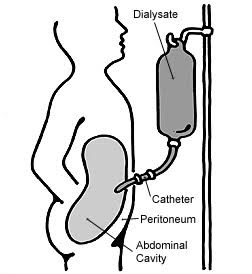Jun
How does peritoneal dialysis work?
- admin
- no comments
- Tags: CAPD, CCPD, PD, Peritoneal Dialysis

When your kidneys are no longer able to effectively remove waste products from your body, your nephrologist may recommend dialysis as part of your treatment plan.
Peritoneal dialysis (PD) is one type of dialysis that can be performed at home or on the go. PD has several advantages over traditional hemodialysis, such as a more flexible diet and lifestyle. (Read more about the benefits of PD in our previous post.)
As you and your doctor are evaluating which dialysis type might be best for you, here are a few things to know about how peritoneal dialysis works to filter your blood.
Preparing for treatment
PD catheter
You’ll undergo an outpatient procedure at least three weeks before beginning PD treatments. During this procedure, a thin tube called a catheter will be placed in your abdomen that will allow you to perform the dialysis exchanges yourself without the use of needles.
PD training
You and your care partner will receive thorough peritoneal dialysis training before treatments begin. You’ll learn how to perform the exchanges on your own, get comfortable with the PD equipment and supplies, and practice cleaning the catheter site to keep infections at bay. Your Cincinnati Home Dialysis care team will guide you every step of the way to help you build confidence in your ability to perform PD treatments.
Performing peritoneal dialysis
The catheter is used to fill your abdomen with a cleansing solution called dialysate. Dialysate contains sugars that extract waste and excess fluids from your body. This solution will stay in your abdomen for a set amount of time, typically between four and six hours. During this time, you can perform your usual daily activities.
At the end of this dwell time, you’ll perform what’s called an exchange. This involves draining the old dialysate out of your abdomen and refilling with fresh solution. Continuous ambulatory peritoneal dialysis (CAPD) can be done by hand three to five times during the day. Continuous cycling peritoneal dialysis (CCPD), on the other hand, can be performed automatically with a machine while you sleep.
The effectiveness of peritoneal dialysis depends on factors such as your size, the amount of dialysate you use, the number of exchanges, and more. As you begin PD, your Cincinnati Home Dialysis care team will check in with you regularly to ensure your treatments are working.
